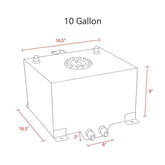What is an exhaust system
Your vehicle's exhaust system is made up of a complex system of pipes and devices that perform four essential functions: collect engine gases, remove harmful substances from those gases, reduce engine noise engine and exhaust air away from the occupants.
4 main parts of the exhaust system
A typical exhaust system consists of several parts connected together by metal pipes. These parts are the exhaust manifold, the catalytic converter, the muffler and tailpipes.
- Exhaust pipe. Also known as the exhaust, this is where the entire system begins. The manifold connects to the vehicle's engine to collect gases created by the combustion of gasoline in the cylinder. The manifold consists of a series of tubes that seal the engine's exhaust ports with flanges.
- Catalytic converter. Exhaust gases from the engine flow through a series of pipes to the catalytic converter from the manifold. The gas contains toxic substances such as carbon monoxide, nitrogen oxides and hydrocarbons. Catalytic converters contain metals such as palladium, rhodium, and platinum. When the gas passes through these metals, a chemical reaction removes up to 90% of the toxins.
- Muffler. The cleaned gas then passes through a pipe to the muffler, an oval or cylindrical chamber designed to reduce car engine noise. Inside the muffler are a series of tubes designed to reflect sound waves as they pass through. Silencers can sometimes create back pressure due to reduced air flow entering the muffler through the device. Back pressure can affect vehicle performance.
- Tailpipes. Once the air is purified and noise is reduced, the remaining air passes through the exhaust to the rear of the vehicle, where it is released into the atmosphere.

What is an exhaust manifold?
The exhaust manifold is part of the exhaust system and is located directly above the cylinder head. It routes exhaust gases collected from individual cylinders to the turbocharger or to the header manifold. Therefore, it is one of the most stressed parts of your car. The force acting on the manifold is enormous, especially when it is exposed to the extremely high temperature of the exhaust gas (which can reach over 1,000°C). Therefore, the material plays a major role: many turbo manifolds are made of cast iron or stainless steel and often contain special alloys. Particularly in motorsport, where high performance is another factor that increases temperatures, the materials used must be equally durable.
How does the exhaust manifold work?
As the first component of the exhaust system, the exhaust manifold collects exhaust gases emitted from the engine cylinders and directs them to the catalytic converter. In turbocharged engines, the turbocharger is located behind the exhaust manifold.
The exhaust manifold is designed to carry exhaust gases out of each cylinder. And that's exactly why it curves. Hot exhaust gases from the cylinder pass through the turbo manifold and into the turbocharger or manifold, where they are collected. At this point, they are cleaned and transferred to the exhaust system. Engine exhaust gases usually enter the manifold horizontally and are directed down from there.
The Benefits Of Exhaust Manifolds
- The exhaust manifolds will traditionally funnel the exhaust gas from the engine.
- Performance exhaust manifolds require very little maintenance, unlike manifolds that need to be periodically tightened.
- Improve engine performance, exhaust plays an important role in improving your engine performance. Efficiently collects exhaust gases from each cylinder and directs them into a single pipe reducing back pressure in the engine's exhaust system
- Increase energy efficiency. When the back pressure in the exhaust system is less, the engine does not have to work as hard to release exhaust gases. This means it can use less fuel to achieve the same level of performance.
- Reduces emissions, routing exhaust gases into a single pipe makes it easier for catalytic converters to convert harmful pollutants into less harmful emissions. This means your car will be more environmentally friendly and comply with emissions regulations.
- Sound is improved. When exhaust gases from each cylinder are collected and directed into a single pipe, it creates a smoother, more consistent exhaust sound. This can result in a more enjoyable driving experience and a nicer exhaust.
In short, the exhaust pipe is very important for your car's exhaust system. This can help improve your car's performance, increase fuel efficiency, reduce emissions and make your car sound better. Investing in a high-quality exhaust is a great first step if you want to upgrade your car's exhaust system.

The exhaust manifold is a part of the engine assembly found on all internal combustion engines. Cast iron manifolds are made as one piece, while pressed steel manifolds are welded together. Both components withstand the high stress and thermal conditions required to trap and release exhaust gases. Even though they are sturdy by nature, they can still cause handling problems. Typically, a faulty exhaust will have a few symptoms that can alert the driver to a problem.
The first symptom of a problem with the exhaust gasket will be excessive engine noise. If the exhaust gasket is defective, it will create an exhaust leak accompanied by a hissing or knocking sound from the engine.
Engine performance problems are another common symptom of exhaust gasket problems. A faulty exhaust gasket can cause the exhaust gasket to leak, leading to engine performance problems such as reduced horsepower, acceleration and fuel economy.
A burning smell coming from the engine compartment is another symptom of an exhaust gasket problem. If the gasket fails and begins to leak near plastic parts or the engine's wiring, these parts can burn from the heat of the exhaust gases. This will create a burning smell in the engine compartment because the components have been exposed to high temperatures. A slight puff of smoke may be accompanied by a foul odor. If there is a burning smell, it should be checked as soon as possible to ensure there are no potential safety risks.









